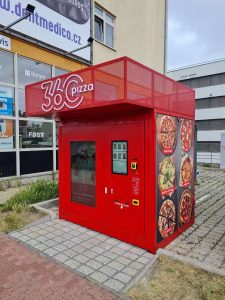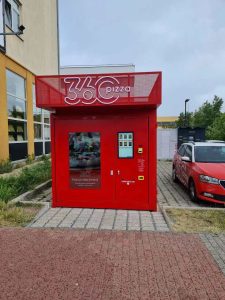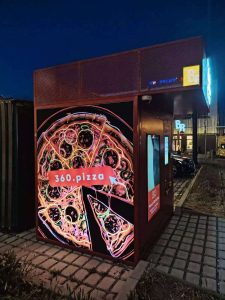A pizza vending machine offers a highly automated and convenient way to provide fresh, hot pizzas on demand. Here’s a breakdown of the solution:
I. Core Concept and Technology:
- Automated Production: The fundamental idea is to automate the entire process from storage to baking and dispensing.
- Refrigerated Storage: Machines hold a stock of pre-made, raw, or partially baked pizzas in refrigerated compartments, typically in individual boxes. Some advanced machines can store up to 70 pizzas.
- Robotic Handling System: When an order is placed, a robotic arm or conveyor system precisely retrieves the selected pizza from storage.
- Rapid Baking Oven: The retrieved pizza is transferred to a specialized oven, often a high-speed convection or pulsed-air oven. These ovens are designed to bake a fresh pizza from scratch (or finish a par-baked one) in a matter of minutes (e.g., 3-4 minutes). Some even have features to automatically open the pizza box lid for baking.
- Customization (Limited): Some machines offer basic customization options like adding extra cheese or selecting different toppings, although the primary focus is on pre-set pizza varieties.
- Intuitive User Interface: A touchscreen display allows customers to browse selections, view nutritional information, and place their order.
- Multiple Payment Options: Machines typically accept credit/debit cards, mobile payments (NFC), and sometimes even cash.
- Dispensing: Once baked, the pizza is presented to the customer through a secure dispensing hatch.
- Remote Monitoring and Management (IoT): Most modern machines are equipped with IoT capabilities, allowing operators to remotely monitor inventory levels, sales data, machine status (temperature, errors), and even schedule maintenance or ingredient deliveries. This significantly reduces the need for constant on-site supervision.
- Quality Control: Integrated sensors ensure pizzas are stored at safe temperatures and track “best before” dates to guarantee freshness.
II. Business Model and Advantages:
- 24/7 Availability: This is a major selling point, as customers can get a hot pizza at any time, day or night, without relying on traditional restaurant hours.
- Low Operational Overhead: Significantly reduces labor costs (no cooks, servers, or cashiers needed on-site), rent (smaller footprint than a restaurant), and utility costs compared to a full-service pizzeria.
- Scalability: Once a successful location is identified, the business model is easily scalable by deploying more machines in different strategic locations.
- Consistent Product: Automation ensures consistent quality and baking standards with every pizza.
- High Profit Margins: With reduced overhead, the profit margins per pizza can be substantial. Companies like PizzaForno have reported strong operating margins.
- Target Market: Ideal for high-traffic locations such as:
- Universities and college campuses
- Airports and train stations
- Shopping malls and entertainment venues
- Hospitals and medical centers
- Large office buildings and industrial parks
- Gas stations and convenience stores
- Apartment complexes and residential areas
- Hotels
- Contactless Experience: Appeals to consumers seeking minimal human interaction, especially in a post-pandemic world.
- Variety of Offerings: Can stock different pizza types (e.g., pepperoni, cheese, veggie, specialized options like vegan or gluten-free) to cater to diverse tastes.
III. Implementation Considerations:
- Machine Acquisition Cost: The initial investment for a high-quality pizza vending machine can be significant (ranging from tens of thousands to over a hundred thousand dollars).
- Pizza Supply Chain: Establishing a reliable and consistent supply of quality pre-made pizzas (or ingredients if the machine assembles them) is crucial. This often involves working with a central commissary or a specialized food supplier.
- Location Strategy: Identifying and securing prime, high-foot-traffic locations with adequate power supply and accessibility for restocking and maintenance. Location fees (rent or percentage of sales) need to be negotiated.
- Maintenance and Servicing: While automated, machines still require regular cleaning, technical maintenance, and occasional repairs. A service plan or in-house technician is essential.
- Inventory Management: Efficient tracking of stock levels and expiration dates to minimize waste and ensure product availability.
- Marketing and Awareness: While convenient, initial marketing efforts might be needed to inform potential customers about the machine’s presence and offerings.
- Health and Safety Regulations: Adhering to local food safety and health regulations is paramount, especially regarding temperature control and hygiene.
In essence, a pizza vending machine solution offers a compelling blend of technology, convenience, and potentially high profitability, addressing the modern consumer’s demand for quick, accessible, and quality food options.




